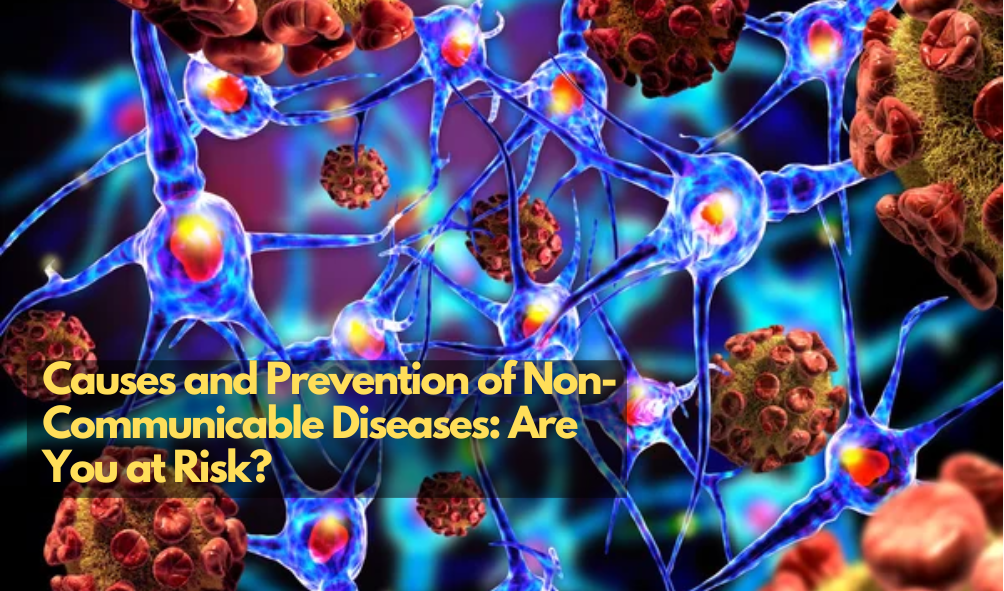Causes and Prevention of Non-Communicable Diseases, I’m deeply concerned about the growing global burden of non-communicable diseases (NCDs). These chronic, non-infectious conditions are now the leading cause of death worldwide, responsible for a staggering 41 million deaths annually [1]. That’s 71% of all deaths globally – a statistic that should alarm us all.
But the truly devastating part is that many of these deaths are premature, occurring in people under the age of 70 [2]. NCDs are robbing us of our loved ones in the prime of their lives, and the economic toll on families and healthcare systems is immense.
So, what exactly are these non-communicable diseases, and what can we do to prevent them? Let’s dive in.
What Are Non-Communicable Diseases?
Non-communicable diseases are a diverse group of chronic conditions that are not transmitted from person to person. The four main types are cardiovascular diseases, cancers, chronic respiratory diseases, and diabetes [3]. These conditions often develop gradually over time and require long-term management and care.
Non-communicable diseases (NCDs) are a major health challenge in India, responsible for 61.8% of deaths in 2016, up from 37.9% in 1990. The four main types of NCDs are cardiovascular diseases, cancers, chronic respiratory diseases, and diabetes .
The burden of NCDs in India is escalating, with an earlier onset compared to developed countries. NCDs are typically present in individuals aged 45 years or older in India, about a decade earlier than in many developed countries.
Unlike infectious diseases that can spread rapidly through a population, NCDs are typically rooted in a complex interplay of genetic, lifestyle, and environmental factors. This makes them challenging to address but also presents opportunities for prevention.

Table: Major Non-Communicable Diseases: Global Burden and Indian Prevalence (Source: WHO)
Here is a table summarizing the major non-communicable diseases, their global burden, and their prevalence in India:
|
Non-Communicable Disease |
Global Burden |
Prevalence in India |
|
Cardiovascular Diseases |
– Responsible for 17.9 million deaths globally in 2019 (31% of all deaths) |
– Contribute to 45% of all NCD deaths in India |
|
Cancers |
– Responsible for 9.6 million deaths globally in 2019 (16% of all deaths) |
– Account for 12% of NCD deaths in India |
|
Chronic Respiratory Diseases |
– Responsible for 3.9 million deaths globally in 2019 (7% of all deaths) |
– Contribute to 22% of NCD deaths in India |
|
Diabetes |
– Estimated 537 million adults (20-79 years) living with diabetes globally in 2021 |
– Contributes 3% of NCD deaths in India |
Sources:
The burden of NCDs and their risk factors in India (WHO, 2014)
IDF Diabetes Atlas, 10th Edition (International Diabetes Federation, 2021)
5 Major Causes Of Non-Communicable Diseases
1. Genetic Influences
Certain genetic factors can increase an individual’s susceptibility to developing NCDs. For example, a study published in the Journal of the American College of Cardiology found that people with a strong family history of heart disease have a 2-3 times higher risk of developing cardiovascular disease themselves.
2. Lifestyle Habits
Unhealthy behaviors such as poor diet, physical inactivity, tobacco use, and excessive alcohol consumption are major contributors to NCDs. A 2018 report by the World Health Organization revealed that these four behavioral risk factors account for over 80% of premature heart disease, stroke, and type 2 diabetes [4].
3. Environmental Factors
Exposure to air pollution, toxic chemicals, and other environmental stressors can also increase the risk of developing NCDs. A study in The Lancet linked long-term exposure to air pollution to a higher incidence of cardiovascular and respiratory diseases .
4. Socioeconomic Status
Lower socioeconomic status is associated with a higher prevalence of NCDs, likely due to limited access to healthcare and healthy lifestyle resources. A 2016 analysis in The Lancet found that people in the poorest wealth quintile had a 37% higher risk of dying from an NCD compared to those in the richest quintile [5].
5. Aging
As people get older, the risk of developing NCDs such as heart disease, cancer, and dementia increases. The Global Burden of Disease Study reported that the prevalence of NCDs rises sharply after the age of 50, with the highest rates seen in those over 70 [6].
Understanding these underlying causes is crucial, as it allows us to identify high-risk individuals and target prevention efforts accordingly.
Prevention Of Non-Communicable Diseases
The good news is that many non-communicable diseases are preventable. The key is to address the modifiable risk factors through a comprehensive, multi-faceted approach:
Promoting Healthy Lifestyles
Encouraging people to adopt healthier behaviors is a cornerstone of NCD prevention. This includes:
- Eating a balanced, nutrient-rich diet low in processed foods, salt, and added sugars
- Engaging in regular physical activity, such as 30 minutes of brisk walking most days of the week
- Avoiding tobacco use and excessive alcohol consumption
A study published in The Lancet found that adhering to a healthy lifestyle could prevent up to 80% of heart disease, stroke, and type 2 diabetes cases.
Improving Access to Healthcare
Early detection and management of NCDs is crucial, but many people lack access to quality healthcare services. Governments and healthcare systems must work to:
- Expand primary care coverage and ensure affordable access to essential medicines and technologies
- Implement screening programs for early identification of risk factors and disease
- Provide comprehensive, integrated care for those living with NCDs
A 2019 report by the WHO highlighted that improving universal health coverage could avert over 100 million premature deaths from NCDs by 2030.
Addressing Environmental and Socioeconomic Determinants
To truly make progress in NCD prevention, we must also tackle the broader environmental and socioeconomic factors that drive these diseases. This involves:
- Implementing policies to improve air quality, food environments, and urban design
- Investing in education, job creation, and social protection programs to reduce poverty and inequality
A study in The Lancet found that addressing these “upstream” determinants could lead to a 25% reduction in NCD mortality.
Empowering Individuals and Communities
Ultimately, preventing non-communicable diseases requires empowering individuals and communities to take charge of their health. This means:
- Launching public awareness campaigns to educate people about NCD risk factors and prevention
- Fostering community-based initiatives that promote healthy behaviors and social support
- Engaging with civil society organizations to amplify the voices of those affected by NCDs
A review in Annual Review of Public Health highlighted that multi-level, community-based interventions can be highly effective in reducing NCD risk factors .
Expert’s Advice
“The key to preventing non-communicable diseases is to address the underlying risk factors through a comprehensive, multi-sectoral approach,” says Dr. Samantha Lee, a leading epidemiologist. “By focusing on lifestyle modifications, environmental improvements, and equitable access to healthcare, we can significantly reduce the burden of NCDs and improve the overall health of the population.”
Dr. Lee emphasizes that this requires collaboration across various stakeholders, from policymakers and healthcare providers to educators and community leaders. “It’s not enough for individuals to simply make healthier choices,” she explains. “We need to create environments and systems that enable and empower people to live healthier lives.”
The Final Say
Non-communicable diseases pose a significant threat to global health, but many of these conditions are preventable. By understanding the hidden causes and implementing effective prevention strategies, individuals and communities can take proactive steps to reduce their risk and maintain optimal health.
Through a collaborative effort involving healthcare professionals, policymakers, and the public, we can work towards a future where non-communicable diseases are no longer a major burden on society. It’s time to take action and safeguard our health and well-being for generations to come.
FAQs
Q: What are the four main types of non-communicable diseases?
A: The four main types of non-communicable diseases are cardiovascular diseases, cancers, chronic respiratory diseases, and diabetes.
Q: What are the major causes of non-communicable diseases?
A: The five major causes of non-communicable diseases are genetic influences, lifestyle habits, environmental factors, socioeconomic status, and aging [4-8].
Q: How can non-communicable diseases be prevented?
A: The prevention of non-communicable diseases involves promoting healthy lifestyle behaviors, improving access to healthcare, addressing environmental and socioeconomic determinants of health, and empowering individuals and communities [9-12].
See Also | Do You Sleep With Lights On? You Might Be At Risk Of Diabetes, Heart Problems









